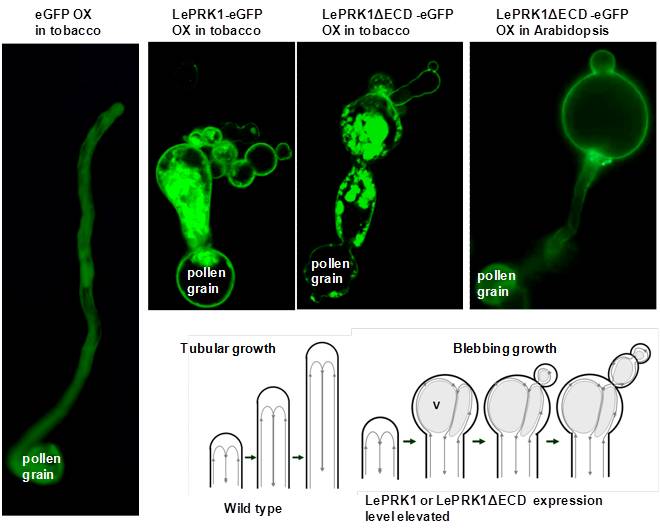Study on the molecular mechanism of the growth mode transformation from tubular growth to blebbing growth caused by overexpression of the Tomato Pollen Receptor Kinase LePRK1
The tubular growth of a pollen tube cell is crucial for sexual reproduction of flowering plants. Recently, a group led by Dr. TANG Weihua, from Shanghai Institute of Plant Physiology and Ecology (SIPPE), Shanghai Institutes for Biological Sciences (SIBS), CAS, presents the evidence that overexpression of LePRK1 or LePRK1ΔECD rewires pollen tube growth to a blebbing mode, through KPP- and PLIM2a-mediated bundling actin filaments from tip plasma membranes.
LePRK1 is a pollen-specific and plasma membrane-localized receptor-like kinase from tomato (Solanum lycopersicum). LePRK1 interacts with another receptor, LePRK2, and with KPP (kinase partner protein), a Rop guanine nucleotide exchange factor. However, the in vivo function of LePRK1 and the underlying mechanism were still unknown.
The researchers from TANG’s lab show that pollen tubes overexpressing LePRK1 or a truncated LePRK1 lacking its extracellular domain (LePRK1ΔECD) have enlarged tips, but also extend their leading edges by producing “blebs”. Coexpression of LePRK1 and tomato PLIM2a, an actin bundling protein that interacts with KPP in a Ca2+ responsive manner, suppressed these LePRK1 overexpression phenotypes, whereas pollen tubes coexpressing KPP, LePRK1 and PLIM2a resumed the blebbing growth mode. It was also found that Arabidopsis thaliana pollen tubes expressing LePRK1ΔECD also grew by blebbing. These results exposed a hidden capability of the pollen tube cell: upon overexpression of a single membrane-localized molecule, LePRK1 or LePRK1ΔECD, it can switch to an alternative mechanism for extension of the leading edge, that is analogous to the blebbing growth mode reported for Dictyostelium and for Drosophila melanogaster stem cells.
This research entitled “Overexpression of the Tomato Pollen Receptor Kinase LePRK1 Rewires Pollen Tube Growth to a Blebbing Mode” has been published online in the Plant Cell on September 5th, 2014.
This project was supported by the Natural Science Foundation of China (grant 30970266 to Dong Zhang and 31170291 to Weihua Tang), the Ministry of Science and Technology of China (grant 2011CB944604 to Dong Zhang, 2011CB100702 and 2012AA10A302 to Weihua Tang) and the US Department of Agriculture (grant CRIS-5335-21000-020-00D to Sheila McCormick).

Overexpression of LePRK1 or LePRK1ΔECD rewires pollen tube tubular growth to a blebbing mode. (Image by Dr. TANG Weihua’s group)
